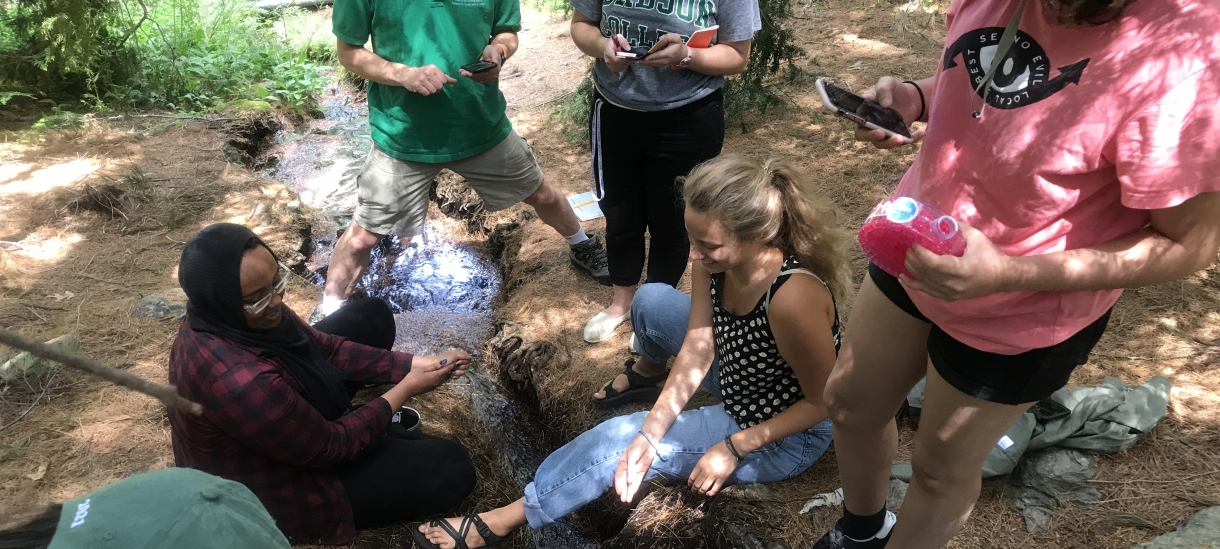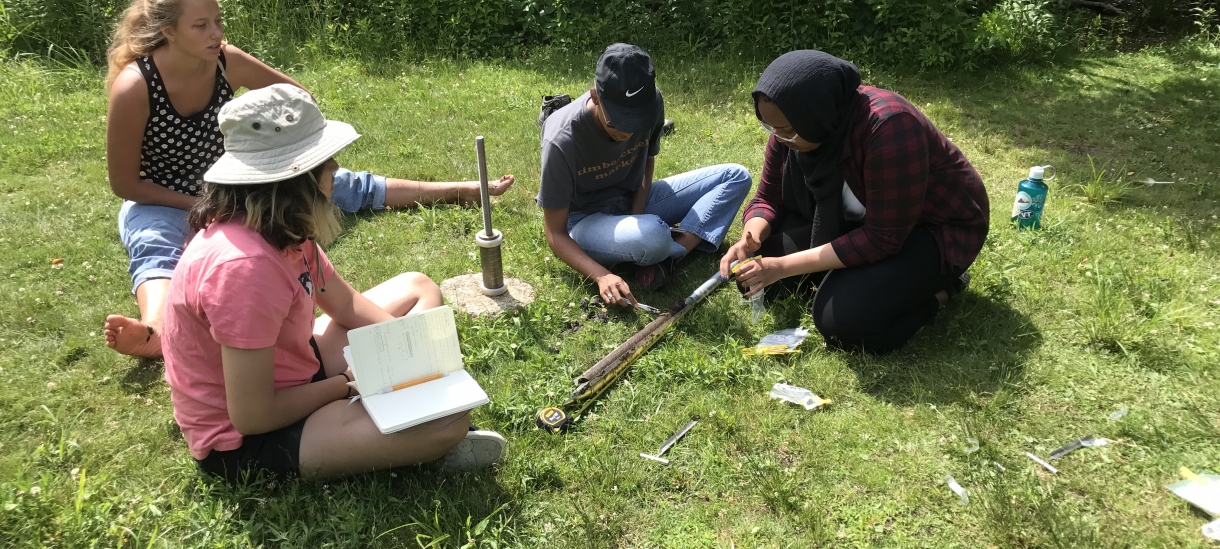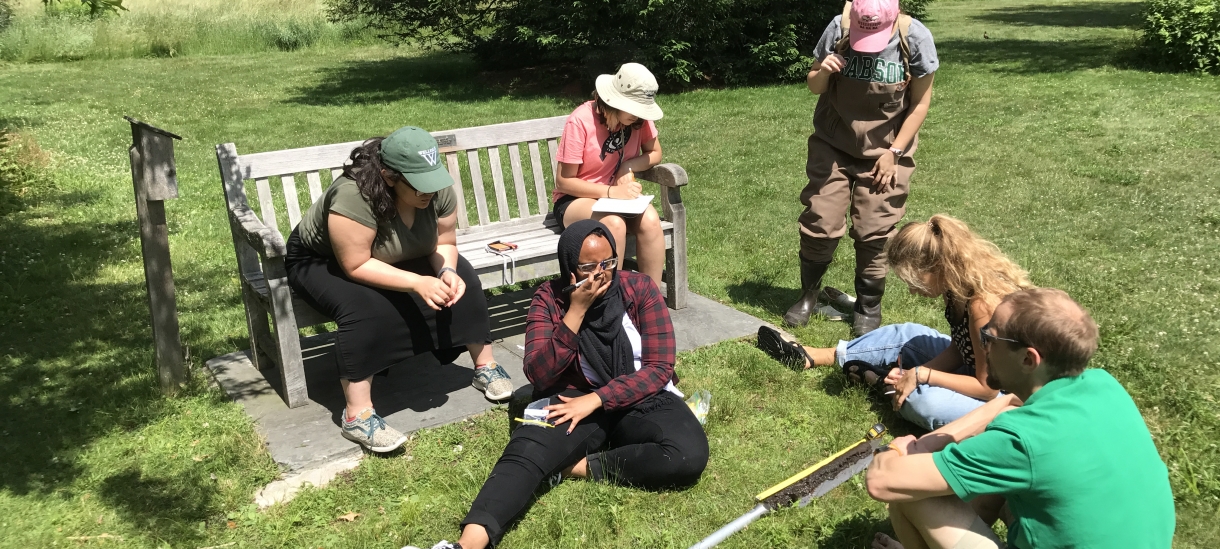Student research is at the heart of the Sciences.
Threading biodiversity, ecology, and education in the built environment: Lessons from the Silver Thread Brook
By: Louisa Crane ’19; Nallely Esparza ’21; Thea Louis ’20; Faisa Warsame ’21
Together, the Silver Thread Brook (ST) and Paramecium Pond (PP) comprise a human-made water feature central to the Wellesley College landscape and Botanical Gardens. Potable (treated) water feeds the ST at a flow rate of approximately 13 gallons per minute, and flows into PP. In recent years concerns regarding the system’s unsustainable water use have prompted the consideration of alternative water management schemes. We explored four aspects of the ST in order to better understand the ecology and chemistry of the system and inform management changes. Our research lays the groundwork for understanding how the constructed ST/PP system can support biodiversity and provide educational, scientific, and recreational opportunities for the College. The four areas of study are as follows:
- Harnessing Energy — In order to better use water in the ST/PP system and to take advantage of the high water velocity at the source of the ST, we designed a water wheel for generating electricity. The water wheel will help bridge the gap between Wellesley College’s high water use and the end goal of using water more efficiently. While these landscape features require water use and power to pump it uphill, there are ways to make this system more sustainable. Implementation of the water wheel accompanied by signage will educate those on campus about the ST/PP system and Botanic Gardens through interactive materials and installations powered by the energy produced by the water wheel.
- Phosphorus Levels — Although phosphorus is an essential nutrient for plant life, excess phosphorus levels in water can speed up the process of eutrophication (the decline of animal and plant life due to a lack of dissolved oxygen). Documenting phosphorus levels is imperative to understanding the ecological health of the system. In Summer 2018, an algal bloom developed and grew in Mirror Pond, a large pool area within the ST. We expect to find there will be more phosphorus in pool areas of the system such as Mirror pond, which explains the algal bloom, which may have a negative impact and lead to eutrophication. We are testing flow rate, if phosphorus is the key nutrient to the algal bloom in Mirror Pond, total phosphorus, and dissolved oxygen.
- Ecological communities — Freshwater macroinvertebrates occupy diverse ecological niches and vary greatly in terms of pollution tolerance. Baselining macroinvertebrate life in the ST informs knowledge of ecological processes in the ST/PP system, which must be understood before making management changes. We sampled macroinvertebrates along the ST and found the brook supports diverse ecological communities; however, spatially there is significant variation in abundance. We found the presence of leaf detritus and aquatic plants facilitates diversity and abundance of macroinvertebrates, while human-introduced substrates (sand and concrete) decrease taxonomic diversity (p = 0.0070). Our data also suggests longer distance from source is associated with more taxonomic diversity and overall abundance of organisms.
- Soil Quality — Soil quality within any environmental system can affect the ability of plants to thrive. At the source of the ST, soil samples reflected the presence of 11 different elements tested in an X-ray fluorescence machine. The majority of these elements pose no threats to the soil, indicating a system capable of sustaining plant life. Iron, manganese, and zirconium are in the highest concentrations in the soil samples. Of these, zirconium is the only chemical that has the potential to be a pollutant to the plants growing in this soil should zirconium become mobilized at an unnaturally fast rate. Soil quality as a proxy for plant health contributes to high dissolved oxygen levels in the water, provides food and/or shelter for animals, and adds to the visual loveliness of the ST.
As a built system, the ST cannot wholly exemplify how a natural brook would interact with a campus environment. Human intervention can impact the biological communities that have created habitats in the ST. The ST supports organisms that otherwise would not be present, provides habitat in which diverse taxa fill structured ecological niches, and contributes to overall campus biodiversity. The ST/PP systems provide opportunities for creative uses of water (such as the water wheel we designed), education of the larger community, visual loveliness, and an outdoor classroom; ultimately encouraging engagement with the outdoors. Our research makes evident the larger need for continued study in order to fully take advantage of potential roles built water features can take on campuses.
Advisor Name: Amy Banzaert; James Battat; Dan Brabander; Nolan Flynn; Kristina Jones; Suzanne Langridge; Jennifer Yang
Advisor Department: Chemistry, Biology, Engineering Studies, Physics, and Geoscience
Department Funding source(s): SC - Paulson
Preventing Salinity from Soiling Plants on Wellesley Campus: Rain Gardens
By: Rebecca Arango and Kim Hernandez, Class Year ’21
For years, Wellesley College grounds has experienced tremendous amounts of salt addition due to the use of chemical deicers on roads and sidewalks during winter. Several types of salts are applied on campus, including MgCl on pathways and NaCl on major roads.There has been abundant research done on the toxicity of chemical deicers and the negative impacts they have on the environment, but not much has been done to assess salt toxicity on Wellesley College campus. As much of the flora at Wellesley is salt-sensitive, the heavy use of road salts can lead to the destruction of these delicate plants through runoff or contaminated irrigation water. To keep our campus healthy and beautiful, we want to test variety of salt-tolerant plants that will not only enhance the Wellesley aesthetic but also function as a filtration system.
In the spring of 2017, students in the Water Challenge group started building a system to more effectively manage precipitation and chemical runoff on campus: rain gardens. As a preliminary step, the group constructed a “mesocosm”, or a model of a rain garden containing potential plants, soil, and a sensor system. We have expanded the foundation of the mesocosm to one that will hold and test six different plants. We were interested in looking for plants that are salt-tolerant and native to New England. The plants we used for this system were Asclepias tuberosa, Liatris squarrosa, Aster novae-angliae, Panicum virgatum, Aquilegia candensis, and Lupinus perennis. In an effort to construct the mesocosms as realistically as possible, we took soil samples from locations potentially impacted by chemical deicers, or road salts, and looked closely at their composition using two different techniques. First, we developed a system for measuring the salinity of soils using electrical conductivity, and we additionally performed
X-ray fluorescence spectroscopy analyses on our samples. Using what we learned, we decided to mimic the concentration of salinity of the soils around campus. After obtaining chemical deicers used on campus, we designed a collection of dilutions at different salinities to test the capacity of filtration our test plants are able to achieve.
The mesocosms will give us the opportunity to experiment in a controlled system and learn which plants will be best to implement on campus near sidewalks. We hope that the mesocosms serve as a platform that enables other students to experiment on plants and track different elements within a filtration system. Ultimately, the results from this and future projects may inform decisions that are made on campus to improve stewardship of the water resources on campus.
Advisor Name: Amy Banzaert, James Battat, Dan Brabander, Nolan Flynn, Kristina Jones, Suzanne Langridge, and Jenn Yang
Advisor Department: Chemistry, Botanic Gardens, Biology, Physics, Engineering Studies, and Geosciences
Department Funding source(s): Paulson Initiative, Sherwood WeLab Fund and Science Center Summer Research Program



